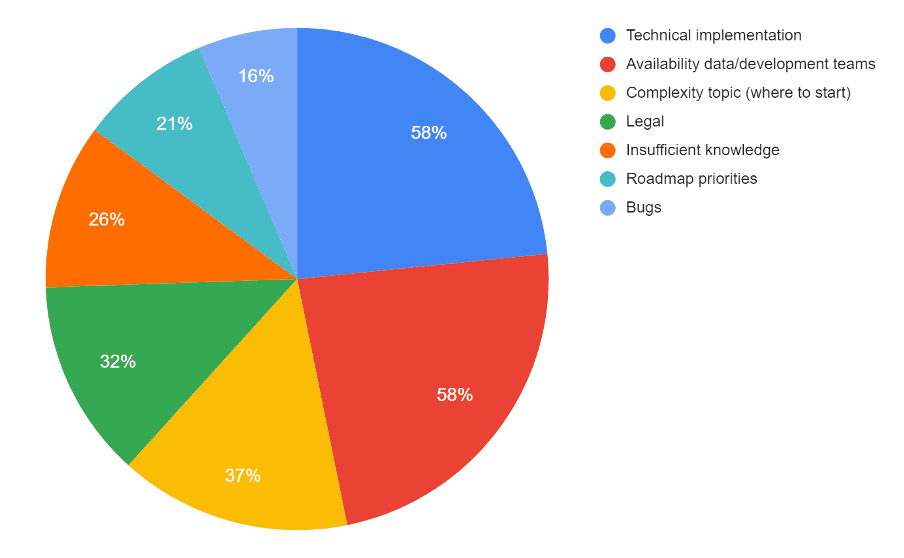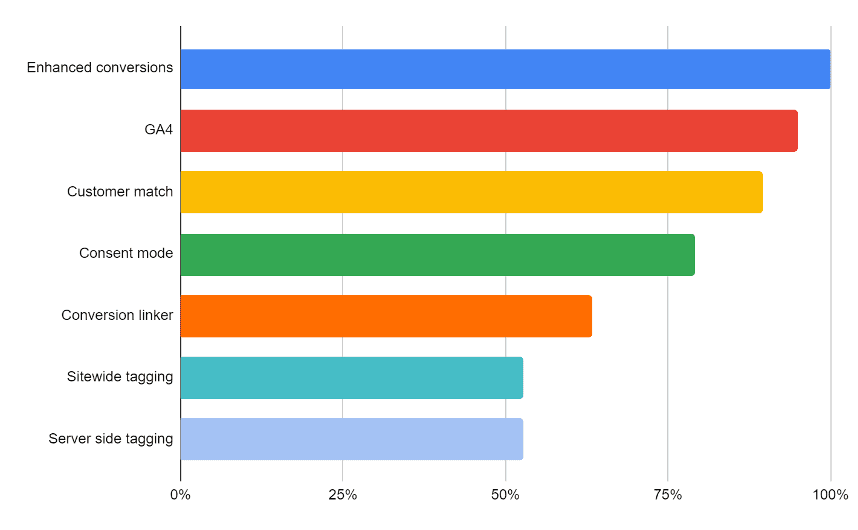As an online marketer there’s no beating around the bush anymore: the future lies in first-party data. Besides this certainty, there is also much that we do not know. In the preliminary research of Nicole Kuper and Nick Oltvoort from the VIA Taskforce Search, it quickly became apparent that many of their Paid Search colleagues have questions about this subject. What exactly does the shift from third-party data to first-party data mean, which solutions are there and where should you start? “To answer these questions, we started by mapping the biggest first-party data obstacles and solutions. Not because we do have all the knowledge in-house, but mainly to show you that your SEA peers have the same questions. The fact remains that much is unclear. But if we join forces, we can come up with great solutions together.” say Nicole and Nick.
In this article you will find a comprehensive overview of the obstacles you encounter when implementing first-party data solutions within Paid Search (SEA). We also share tips for dealing with these obstacles and an overview of existing first-party data solutions, so you can get started right away!
1. Introduction – Priority to privacy
But first, let’s take a step back. Where did the first-party data story actually start and why? Despite previous cookie legislation, the change really started with changes in privacy legislation. On May 25th, 2018, the AVG became applicable, also known as GDPR in Europe. ‘Consent and transparency’ are central to this law. This means that a user must know whether identifiers are used and which personal data are processed, stored and then used for purposes such as (re)targeting and advertising. In addition, this user must be able to actively indicate their preference for whether or not to store their personal data.
As a result of the enforcement of these changes, many large parties have had to adapt. Safari (Apple) and Firefox (Mozilla) already decided in 2019 and 2020 to block third-party cookies ‘by default’ to protect all users, but especially themselves. Chrome (Google) is planning the same via Privacy Sandbox, but it will take a while. The first plans were announced for 2022, but this has now become the end of 2024. Apple also decided to give more control to their user with the new iOS 14.5 update. For example, every app must ask permission via a pop-up if they can track you through various third-party apps and websites. This active question will cause many users to decline it.
By addressing the privacy issue of browsers and apps, the front door is being closed. In this way, advertising platforms can track far fewer users and use far fewer identifiers. If Google joins Apple and Mozilla with Chrome (66% of all users) in 2024, advertisers will miss out on a lot of data, which will have a major impact on the performance of our advertisements. But this only happens if we do not pursue an alternative strategy in the meantime and adopt new solutions. So, how can we capitalize on this? What are the biggest obstacles to starting with a first-party data strategy and which solutions are already being used?
We asked our peers in a survey.*
2. The biggest first-party data obstacles
Many obstacles are encountered when implementing first-party data solutions. No less than 95% of the respondents have indicated that they run into problems. Another 63% are not satisfied with the rate of adoption of the solutions within their own company, both on the agency and client side. All respondents have taken the first steps towards implementation. In addition, 79% are already working on integrations, of which 26% are very active. 21% get stuck in the strategy because the process is slowed down internally. The biggest obstacles seem to lie with the technical implementation and the availability of data and development teams, but the complexity of the subject also plays a major role. Below you can find the results.

Do you recognize these obstacles? Below we will discuss them one by one and offer a few tips.
Technical implementation & availability of data- and development teams
The biggest obstacle lies in the technical implementation of first-party data solutions. All current solutions require technical competences and require good cooperation between developers, data specialists and SEA specialists. Due to the lack of this cooperation, lead times are often longer, but also because first-party data is often not given sufficient priority within data and development teams. Everyone must also have sufficient knowledge to achieve the common goal.
Tip! Make a business case focusing on what benefit the first-party data solution can provide and what impact it can have if it is not used. Then present this within the organization to convince (internal) stakeholders of the urgency, but especially to create sufficient support among stakeholders outside the data team.
Complexity of the subject & insufficient knowledge
There are many first-party data solutions and they vary by advertising platform. In addition, there is still a lot of uncertainty and this combination makes it a complex subject. It is also not always clear which solutions there are, what should be given the highest priority and how high the urgency is. This also means that there is often too little knowledge among specialists and stakeholders to arrive at a sound strategy. At the bottom of this article, you can find a checklist to help you visualize the complexity of each solution and a step-by-step explanation of how to implement it. To help you get started, a ‘priority label’ has also been given to the solution.
Tip! Do preliminary research into the various solutions to gain insight into the advantages and disadvantages yourself. In addition, keep an eye on market developments regarding privacy and first-party data so that you can make timely adjustments if the situation changes. Think of the plans of Apple and Google, developments in legislation and the solutions that are being discussed by other parties. Consult blogs, Google documentation or specialists on this subject to increase your knowledge level. Then start drawing up and developing a strategy.
Legal
First-party data solutions use personal data and/or identifiers and are therefore subject to GDPR legislation. As a result, you must always have unambiguous permission to send this data to advertising platforms or you must anonymize the data completely, so that it cannot be traced back to an individual. Organizations and in particular the ‘Legal’ departments regularly encounter objections to this. Can we share our (customer) data with third parties and what are the consequences?
Tip! Do not just share personal data/identifiers with advertising platforms. Make sure that consent is always given for both cookies and first-party data processing and that this consent status is always available. This way you can be sure that only data with the correct consent is sent to the platforms. Check with the Legal teams. A consent management platform can help with the proper execution of these processes.
Roadmap of priorities
Developments within SEA are moving fast; In addition to first-party data solutions, there is much more at stake. For example, 53% of the respondents indicate that they prioritize the implementation of Performance Max. The further development of campaign structures such as Hagakure is also given priority by 16% of the respondents. Still, 32% of the respondents say they have no higher priorities than first-party data solutions.
Tip! For optimal performance of new campaign structures and campaign types, it is important to have as much conversion data as possible. To achieve this, first-party data is important. Clear space on the roadmap for the first party data solutions listed in our checklist and apply them step-by-step according to the priority indicated.
Bugs
The solutions offered by parties such as Google are fairly new. As a result, there may still be bugs in the products, such as issues in measurability.
Tip! Do you see a strange trend in the (conversion) data after implementing a solution? Always contact support or your account manager. If necessary, they can watch and possibly report bugs directly to the product teams. In addition, always try to test a solution on a small scale first to experience the impact before you implement it everywhere.
3. The first-party data solutions
Now that we know how to cope with the obstacles, we can get started. The only question that is left to answer is: which first-party data solutions are available? The solutions that are being offered by (mostly) Google are:
The survey shows that all solutions – to varying degrees – are already being used by the respondents. Enhanced conversions, GA4, Customer match and Consent mode are currently the most popular among the SEA specialists. Enhanced Conversions has even been adopted by all respondents. Below you can find the degree of adoption per solution.

It is striking to see that some first party data solutions whose priority in our opinion is relatively high have the lowest adoption rate. By priority we mean the complexity versus the impact. To point you in the right direction during implementation, we have made a checklist of the first party data solutions in order of priority that you can find at the end of this article.
Sitewide tagging & conversion linker
To get the most accurate audiences and measurements, it’s important to use the global site tag, or place the necessary pixels via GTM and use the Conversion linker. Using these methods ensures that such signals are stored in a first-party context, making them less susceptible to browser restrictions.
It is striking that Conversion linker and Sitewide tagging via GTM are relatively easy to implement but there seems to be less knowledge about it. It is suspected that they have often already been implemented but specialists are not always aware of them.
Google Analytics 4 (GA4)
Google Analytics 4, the new version of Analytics that collects event-based data from both websites and apps, uses machine learning and modeling to “fill in the gaps” when users choose not to accept cookies. In this way, GA4 provides insights on user engagement while keeping their data anonymous. In addition, in GA4 you can use predictive audiences, for example ‘buyers likely to buy within 7 days’. Overall, compared to Universal Analytics, GA4 measures more data and has better cross-device reporting. In addition, since July 1 2023, no new hits have been processed in the regular Universal Analytics. That is why a switch to GA4 is of great importance.
Server side tagging
At the moment, tracking often still takes place by placing cookies on the visitor’s side. Also called client side. As an alternative to this, many large platforms such as Google make it possible to forward the tracking of visitor behavior directly to the platform. This is also known as server-side tagging. Platforms give a click ID to visitors who click through to your website from their platform. You send this click ID together with all actions that the visitor has done on your website, this is your own data, directly back to the platform via an API. The advantage of this is that it is more resistant to the disappearance of third-party cookies, you have more control over your own data and you can further enrich it with margin data, for example.
Enhanced conversions
Enhanced conversions is used to improve the accuracy of the conversion data. This first-party data solution complements existing conversion tags; hashed, anonymized data from converted website users is sent to Google. It is then matched with logged in Google accounts to attribute a click or impression. On average, according to Google, this results in an increase in conversion of 5% in Search and 17% on YouTube. These percentages are expected to increase in the future. NB! The first-party data (such as email addresses) must be available where the conversion tag is triggered.
Customer match lists
With Customer match, first-party data is used to reach not only online, but also offline customers. This is data that Google does not have. Here too, the data is matched with logged-in Google accounts. Google then increases reach by targeting similar profiles. Smart Bidding strategies use the Customer match signals to determine relevance and adjust bids accordingly. This process can be set up manually via importing customer lists, or automated using a Customer Data Platform.
Consent mode
By using Consent mode, the consent status of a user is passed on to Google. Google respects this status and adjusts its data processing accordingly. If consent is not given, Google uses cookieless and privacy-friendly signals to model conversions.
4. What’s next?
Whether these solutions are enough to compensate for the loss of third-party cookies and thus insights remains the question. Only 17% of the survey respondents think yes, 22% think no and 61% don’t know. The latter percentage in particular is indicative of the current sentiment in the market. The many changes follow each other in rapid succession and it is difficult to predict what the future will look like.
Many specialists first want to see how well the current solutions work and do not yet think about possible future solutions. They are mainly looking for automated and simple solutions, so that non-technical marketers can also work with them.
Conclusions
The future of online marketing lies in first-party data. In a world that is becoming increasingly automated, you can only be distinctive if you add your own unique data to algorithms. This unique first-party data is key to creating a differentiating strategy.
Fortunately, we see that more and more SEA marketers are recognizing the benefits of first-party data and solutions such as Enhanced conversion, GA4 and Customer match are becoming increasingly popular. However, there is still work to be done to increase the level of knowledge of all these different solutions and to promote the adoption of more complex solutions, such as server side tagging.
Our advice is to start implementing first-party data solutions quickly. Make clear business cases for customers or internal stakeholders, explaining why this is necessary and what the impact is on the results. This makes it easier to overcome technical implementation and obstacles, such as the availability of data and development teams.
With the rapid changes in this field, it is difficult to predict what the future will look like and which solutions will become most important. What is certain is that failing to implement first-party data solutions will degrade the performance of your campaigns. Therefore, make sure you are as prepared as possible and start implementing the available first-party data solutions today.
Want to know more about getting your Legal department on board of your first-party data strategy? This article might interest you.
*Disclaimer: the results of the survey are based on the input of 19 respondents.

 BLOG
BLOG







